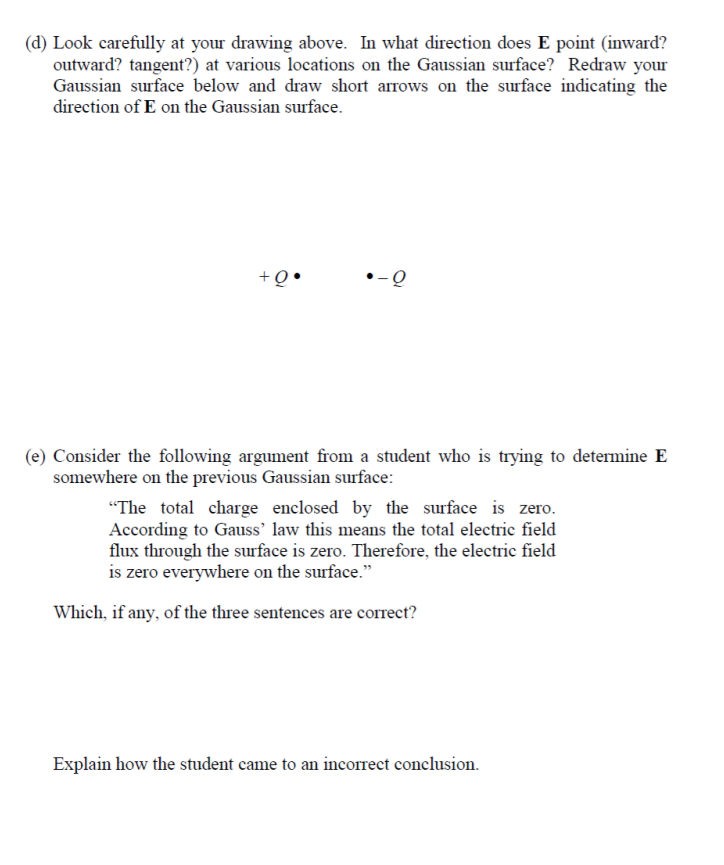(d) Look carefully at your drawing above. In what direction does E point (inward? outward? tangent?) at various locations on the Gaussian surface? Redraw your Gaussian surface below and draw short arrows on the surface indicating the direction of E on the Gaussian surface. +Q• (e) Consider the following argument from a student who is trying to detemine E somewhere on the previous Gaussian surface: "The total charge enclosed by the surface is zero. According to Gauss’ law this means the total electric field flux through the surface is zero. Therefore, the electric field is zero everywhere on the surface." Which, if any, of the three sentences are correct? Explain how the student came to an incorrect conclusion.
(d) Look carefully at your drawing above. In what direction does E point (inward? outward? tangent?) at various locations on the Gaussian surface? Redraw your Gaussian surface below and draw short arrows on the surface indicating the direction of E on the Gaussian surface. +Q• (e) Consider the following argument from a student who is trying to detemine E somewhere on the previous Gaussian surface: "The total charge enclosed by the surface is zero. According to Gauss’ law this means the total electric field flux through the surface is zero. Therefore, the electric field is zero everywhere on the surface." Which, if any, of the three sentences are correct? Explain how the student came to an incorrect conclusion.
College Physics
10th Edition
ISBN:9781285737027
Author:Raymond A. Serway, Chris Vuille
Publisher:Raymond A. Serway, Chris Vuille
Chapter15: Electric Forces And Electric Fields
Section: Chapter Questions
Problem 36P: (a) Sketch the electric field pattern around two positive point charges of magnitude 1 C placed...
Related questions
Question

Transcribed Image Text:(d) Look carefully at your drawing above. In what direction does E point (inward?
outward? tangent?) at various locations on the Gaussian surface? Redraw your
Gaussian surface below and draw short arrows on the surface indicating the
direction of E on the Gaussian surface.
+Q•
Consider the following argument from a student who is trying to determine E
somewhere on the previous Gaussian surface:
"The total charge enclosed by the surface is zero.
According to Gauss’ law this means the total electric field
flux through the surface is zero. Therefore, the electric field
is zero everywhere on the surface."
Which, if any, of the three sentences are correct?
Explain how the student came to an incorrect conclusion.
![6. Consider two point charges of opposite sign as shown:
X
+Q
-오
(a) In what direction is the electric field at the point indicated? Draw a vector on the
sketch above at the point X to represent E. [Hint: Use vector addition.]
(b) On the sketch below, draw several (at least ten) electric field lines for the
configuration above. This should be enough to indicate E in much of the vicinity
of the two charges.
(c) On your drawing above, add a spherical Gaussian surface that encloses both
charges, centered on the point midway between the charges. Make it fairly large,
but be sure several of the electric field lines penetrate the Gaussian sphere. Add
more field lines as needed.](/v2/_next/image?url=https%3A%2F%2Fcontent.bartleby.com%2Fqna-images%2Fquestion%2F9f8ea0c3-20cc-4167-a0d0-5d27a7bf8fa1%2F0e06b962-7bf6-4ba0-a61a-263e45ee1b15%2Fx3mvv6e_processed.png&w=3840&q=75)
Transcribed Image Text:6. Consider two point charges of opposite sign as shown:
X
+Q
-오
(a) In what direction is the electric field at the point indicated? Draw a vector on the
sketch above at the point X to represent E. [Hint: Use vector addition.]
(b) On the sketch below, draw several (at least ten) electric field lines for the
configuration above. This should be enough to indicate E in much of the vicinity
of the two charges.
(c) On your drawing above, add a spherical Gaussian surface that encloses both
charges, centered on the point midway between the charges. Make it fairly large,
but be sure several of the electric field lines penetrate the Gaussian sphere. Add
more field lines as needed.
Expert Solution
This question has been solved!
Explore an expertly crafted, step-by-step solution for a thorough understanding of key concepts.
This is a popular solution!
Trending now
This is a popular solution!
Step by step
Solved in 2 steps with 2 images

Knowledge Booster
Learn more about
Need a deep-dive on the concept behind this application? Look no further. Learn more about this topic, physics and related others by exploring similar questions and additional content below.Recommended textbooks for you

College Physics
Physics
ISBN:
9781285737027
Author:
Raymond A. Serway, Chris Vuille
Publisher:
Cengage Learning

College Physics
Physics
ISBN:
9781938168000
Author:
Paul Peter Urone, Roger Hinrichs
Publisher:
OpenStax College

College Physics
Physics
ISBN:
9781305952300
Author:
Raymond A. Serway, Chris Vuille
Publisher:
Cengage Learning

College Physics
Physics
ISBN:
9781285737027
Author:
Raymond A. Serway, Chris Vuille
Publisher:
Cengage Learning

College Physics
Physics
ISBN:
9781938168000
Author:
Paul Peter Urone, Roger Hinrichs
Publisher:
OpenStax College

College Physics
Physics
ISBN:
9781305952300
Author:
Raymond A. Serway, Chris Vuille
Publisher:
Cengage Learning


Principles of Physics: A Calculus-Based Text
Physics
ISBN:
9781133104261
Author:
Raymond A. Serway, John W. Jewett
Publisher:
Cengage Learning

Glencoe Physics: Principles and Problems, Student…
Physics
ISBN:
9780078807213
Author:
Paul W. Zitzewitz
Publisher:
Glencoe/McGraw-Hill